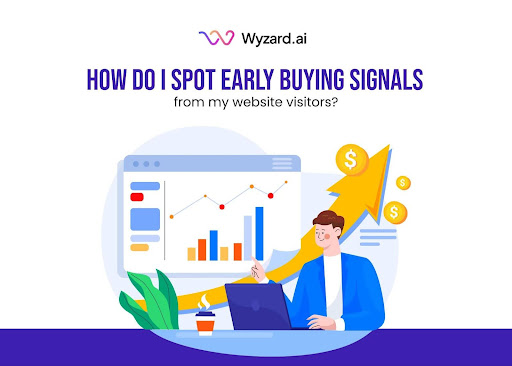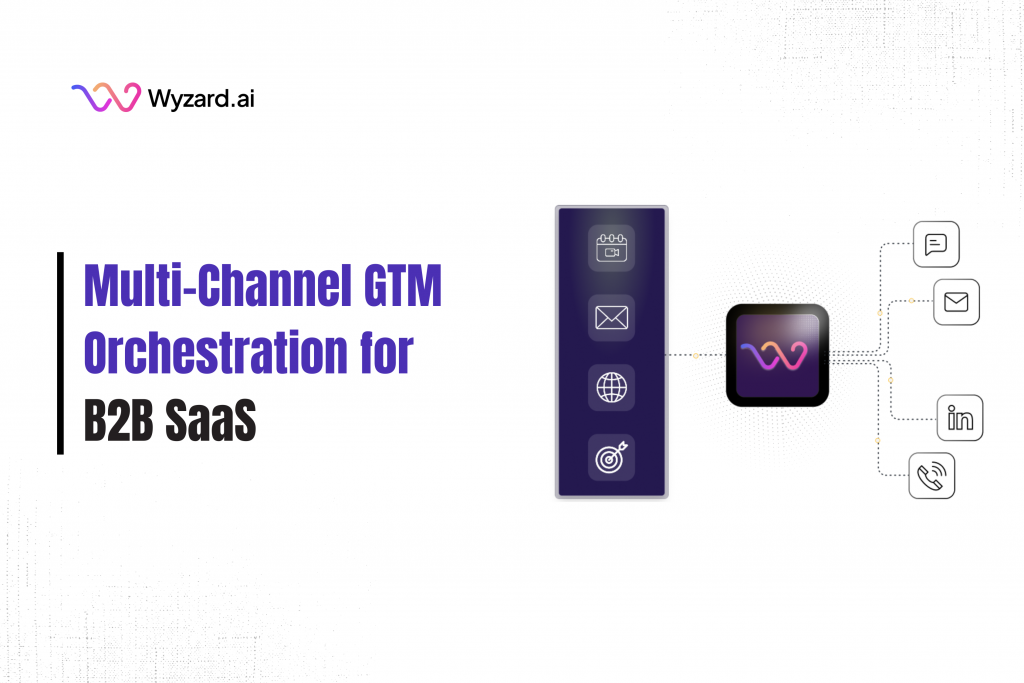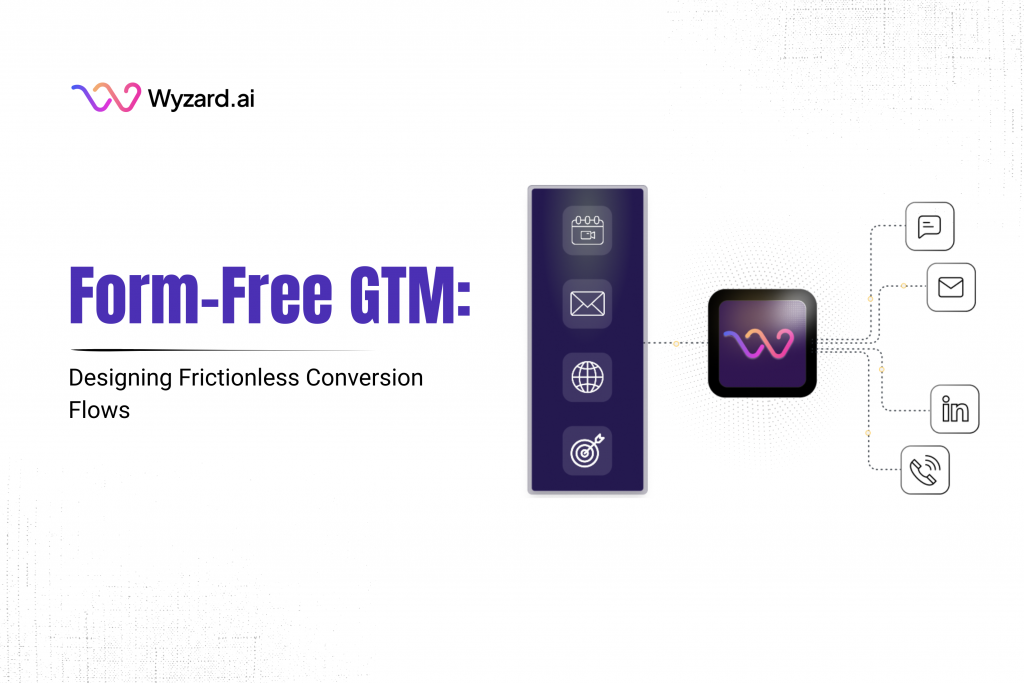If you run marketing or revenue for a B2B SaaS company, the goal is clear: turn GTM spend into ...

Subscribe Now
Your website visitor just spent eight minutes on your pricing page, downloaded your implementation guide, and returned three times this week. Yet, your sales team has no idea they exist.
This scenario plays out hundreds of times across B2B SaaS companies. Marketing teams generate traffic, but the buying intent signals get lost in disconnected tools. By the time sales reach out, the prospect has already moved to a competitor who responded faster.
The reality is stark: most B2B buyers complete 70% of their purchase decision before talking to sales. During this silent evaluation phase, they leave behind dozens of buying intent signals on your website. The companies that capture and act on these signals first win the deal.
This guide shows you exactly how to spot early buyer intent data from your website visitors, which signals matter most, and how to turn those moments of interest into revenue opportunities.
What Are Buying Intent Signals on Your Website?
Buying intent signals are specific actions your website visitors take that indicate they’re actively evaluating a solution. These signals reveal where someone sits in their purchase journey and how close they are to making a decision.
Think of buyer intent as digital body language. When a prospect repeatedly visits your product comparison page, they’re essentially raising their hand and saying, “I’m comparing options.” When they download technical documentation, they’re saying, “I need to understand implementation.”
The challenge most marketing and sales teams face isn’t a lack of signals. It’s these signals that scatter across different tools, your website analytics, marketing automation platform, CRM, and chat systems. Each tool captures fragments of the buyer’s journey, but no single system connects them into a complete picture.
B2B buyer intent data falls into two categories: explicit and implicit. Explicit signals are direct actions like requesting a demo or filling out a contact form. Implicit signals are behavioral patterns like page visits, content downloads, and engagement frequency. Both types matter, but implicit signals often appear much earlier in the buying journey, giving you a competitive advantage.
Why Tracking Buyer Intent Data Matters for B2B SaaS
The window to engage a prospect showing buying intent signals is surprisingly narrow. When someone demonstrates active interest, responding within the first hour increases your chances of conversion by nearly 60%.
Here’s what happens when you track sales intent data effectively:
Your marketing team identifies which accounts are actively researching solutions. Instead of treating all website visitors the same, you prioritize resources on prospects showing multiple buying intent signals. Your outreach becomes timely instead of random.
Your sales team stops wasting time on cold leads. They focus conversations on prospects who’ve already demonstrated interest through their behavior. These warmer conversations convert at significantly higher rates than cold outreach.
Your revenue operations become more efficient. Rather than scaling headcount to handle more leads, you scale intelligence. You know which prospects to pursue, when to reach out, and what messaging will resonate based on the content they’ve consumed.
Types of Buying Intent Signals to Monitor
Not all visitor behaviors carry equal weight. Some actions strongly indicate purchase readiness, while others suggest early-stage research. Understanding these differences helps you prioritize your response.
| Signal Type | Examples | Intent Level | Recommended Action |
| High-Intent Behavioral | Pricing page visits, demo requests, free trial signups, and technical documentation downloads | Strong | Immediate sales outreach within 1 hour |
| Medium-Intent Engagement | Multiple return visits, case study downloads, product feature comparisons, and email link clicks | Moderate | Personalized nurture sequence, schedule follow-up |
| Early-Stage Research | Blog content, educational resources, and general industry content | Low | Add to the nurture track, monitor for progression |
| Collaborative Signals | Multiple users from the same company shared content internally, and cross-departmental visits | Very Strong | Multi-threaded outreach, executive engagement |
High-Intent Behavioral Signals:
These actions show someone is in active evaluation mode. When a visitor requests a demo or starts a free trial, they’re explicitly stating interest. Pricing page visits signal budget consideration. Technical documentation downloads indicate they’re thinking about implementation feasibility.
The strongest signal? Multiple team members from the same company are visiting relevant pages. This suggests internal discussions are happening and a decision process is underway.
Medium-Intent Engagement Signals:
Pattern matters more than individual actions here. A single blog visit means little, but someone who returns three times in a week and downloads a case study is demonstrating sustained interest. Email engagement, especially clicking through to product pages, shows they’re receptive to your messaging.
Watch for progressive engagement. A visitor who moves from blog content to product pages to pricing information is traveling down the buying journey.
Early-Stage Research Signals:
These visitors are problem-aware but not yet solution-aware. They’re consuming educational content to understand their challenges better. While not ready for sales conversations, they’re valuable for nurture programs.
Track these visitors because today’s researcher becomes tomorrow’s buyer. Understanding intent data at this stage helps you provide the right content to move them forward.
How to Detect B2B Buyer Intent Data Early
Spotting buying intent signals requires systematic tracking across your digital properties. Most companies have the data but lack the systems to surface actionable insights in real-time.
Set Up Proper Analytics Tracking:
Start with your website analytics platform. Configure event tracking for high-value actions: pricing page views, document downloads, video completions, and form submissions. Set up custom segments to identify visitors who demonstrate multiple signals within a short timeframe.
Create alerts for threshold behaviors. For example, trigger a notification when someone visits your pricing page three times in a week, or when multiple users from the same company visit within 48 hours.
Monitor Cross-Channel Engagement:
Buyer intent signals rarely appear on a single channel. Track how prospects move between your website, email campaigns, social platforms, and other touchpoints. Someone who clicks an email link, visits three product pages, and returns via organic search is showing strong intent.
Your marketing automation platform should track email engagement patterns. High open rates combined with consistent click-throughs indicate growing interest. Progressive content consumption, moving from awareness content to decision-stage resources, signals advancement through the buying journey.
Identify Company-Level Patterns:
Individual visitor tracking only tells part of the story. Company-level tracking reveals when an organization is seriously evaluating your solution. Tools that identify visiting companies through IP address resolution can surface accounts showing collective interest, even when individuals don’t fill out forms.
Watch for these company-level signals: multiple departments visiting your site, increasing visit frequency over time, and engagement with bottom-funnel content from various team members.
Track Buying Committee Engagement:
B2B purchases involve multiple stakeholders. Early buyer intent data often comes from researchers and influencers before decision-makers engage. Map the roles visiting your site, are you seeing technical evaluators, end users, or executives?
When you notice cross-functional engagement, it indicates the buying committee is forming. This is your signal to provide resources tailored to different stakeholder concerns.
Tools and Technology for Capturing Sales Intent Data
Manually tracking all these buying intent signals across tools is impossible at scale. This is where technology that unifies signal capture becomes critical.
The Scattered Signal Problem:
Most GTM teams work with fragmented systems. Your website analytics capture page views. Your marketing automation platform tracks email engagement. Your CRM holds form submissions. Your chat tool logs conversations. Each system generates buyer intent data, but none of them talk to each other effectively.
This fragmentation creates three problems: signals get missed entirely, response times lag while you manually piece together information, and you can’t prioritize prospects because you lack a complete view of their engagement.
The Signal-to-Revenue Approach:
Wyzard.ai addresses this by functioning as your Signal-to-Revenue AI. Rather than trying to manually connect data across platforms, Wyzard, the Signal-to-Revenue AI, captures buying intent signals from your website visitors in real-time and orchestrates immediate responses across your GTM tools.
Here’s how it works: When a visitor demonstrates buyer intent through their behavior, Wyzard.ai captures that signal instantly. The platform then triggers appropriate actions, whether that’s a personalized chat interaction through Agentic Chat, a contextual email via Agentic Email, or an InMail through Agentic InMail.
The system doesn’t replace your existing tools. Instead, it integrates with your marketing automation, CRM, and communication platforms, acting as the orchestration layer that ensures every buying moment gets acted upon.
What Makes Signal Capture Effective:
Real-time detection matters more than historical analysis. By the time you review last week’s analytics, your hottest prospects have moved on. Effective systems identify sales intent data as it happens and trigger immediate responses.
Context matters as much as speed. Knowing someone visited your pricing page is useful. Knowing they visited it after downloading your ROI calculator and comparing your features against competitors is actionable intelligence.
The platform should unify signals across channels. A complete picture emerges when you see website behavior alongside email engagement, social interactions, and form submissions.
Turning Buyer Intent Signals Into Revenue
Detecting buying intent signals is only valuable if you act on them. The gap between signal detection and response is where most revenue opportunities leak.
Respond Based on Signal Strength:
Not every buying intent signal warrants immediate sales outreach. Match your response to the intent level demonstrated. High-intent signals (demo requests, pricing inquiries, free trial starts) deserve direct sales engagement within the hour.
Medium-intent signals (case study downloads, multiple return visits) work better with personalized nurture sequences that provide additional relevant content and gradual sales engagement.
Early-stage signals benefit from automated nurture tracks that educate prospects and guide them toward evaluation.
Personalize Based on Behavior:
Generic outreach wastes the intelligence you’ve gathered. Use the specific buyer intent data you’ve captured to personalize your approach. If someone spent time on your integration documentation, lead your conversation with how your solution connects to their existing stack.
When multiple team members from an account engage with your content, tailor messaging to address different stakeholder concerns. Your technical audience needs implementation details. Your executive audience needs business impact.
Create Response Playbooks:
Document how your team should respond to different combinations of buying intent signals. When someone demonstrates X behavior, trigger Y response within Z timeframe. These playbooks ensure consistent, timely responses regardless of who’s monitoring signals.
Your playbooks should specify which team member responds (marketing, sales, or success), what messaging to use, and what next steps to offer. Clear playbooks turn signal detection into systematic revenue generation.
Measure What Matters:
Track the metrics that show whether your buyer intent data strategy drives results: time from signal to response, conversion rates by signal type, pipeline velocity for signal-driven leads, and revenue influenced by early signal detection.
These metrics reveal which buying intent signals most strongly predict revenue, helping you refine where to focus attention.
Stop Missing the Signals That Matter
Every day, prospects showing strong buyer intent visit your website, evaluate your solution, and make decisions. The companies that spot these buying intent signals early and respond appropriately win more deals with shorter sales cycles.
The difference between a prospect who becomes a customer and one who chooses a competitor often comes down to timing and relevance. When you capture sales intent data in real-time and orchestrate immediate, contextual responses, you meet prospects at their moment of interest.
Your website visitors are already telling you they’re ready to buy. Wyzard, the Signal-to-Revenue AI, helps you hear those signals and turn them into revenue by connecting your tools, capturing buyer intent instantly, and orchestrating the right GTM actions automatically.
The question isn’t whether buying intent signals exist in your website traffic. They do. The question is whether you have the systems in place to spot them early, respond quickly, and convert that interest into a pipeline.
FAQs
1. What are the strongest buying intent signals I should prioritize?
High-intent signals like pricing page visits, demo requests, and multiple team members from the same company visiting within 48 hours indicate immediate purchase readiness. These warrant direct sales outreach within one hour for maximum conversion potential.
2. How quickly should I respond to different types of buyer intent signals?
High-intent behaviors require immediate response within the first hour, while medium-intent engagement works better with personalized nurture sequences. Early-stage research signals benefit from automated educational content tracks rather than direct sales contact.
3. What’s the difference between explicit and implicit buyer intent data?
Explicit signals are direct actions like demo requests or contact forms, while implicit signals include behavioral patterns like repeat visits and content downloads. Implicit signals appear earlier in the buying journey, giving you a competitive advantage when captured properly.
4. How can I track buyer intent signals when they’re scattered across different tools? Most companies struggle with fragmented systems where signals get lost between analytics, CRM, and marketing platforms. Signal-to-Revenue AI solutions like Wyzard.ai unify these touchpoints, capturing real-time intent and triggering immediate responses across your GTM tools.
5. Why do company-level buying intent patterns matter more than individual visitor tracking?
B2B purchases involve multiple stakeholders, so tracking entire organizations reveals when buying committees form. Multiple departments visiting your site or cross-functional engagement with bottom-funnel content indicates serious evaluation and warrants multi-threaded outreach.
Other blogs
The latest industry news, interviews, technologies, and resources.
Form-Free GTM: Designing Frictionless Conversion Flows
A visitor lands on your pricing page. They are ready to talk, not to wrestle with a 12-field form. ...

December 8, 2025
Outcome-Led Paid Campaigns: Beyond Clicks and CPL
You put serious money into paid media. Dashboards show strong CTR and healthy CPL. The next slide hits and ...

 We’ve secured funding to power Signal-to-Revenue AI to GTM teams globally. →
We’ve secured funding to power Signal-to-Revenue AI to GTM teams globally. →


